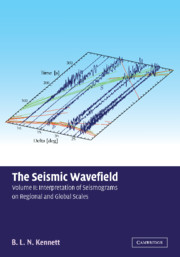Book contents
- Frontmatter
- Contents
- Preface to Volume II
- Part III Local and Regional Events
- Part IV Global Wave Propagation
- 24 The Nature of the Global Wavefield
- 25 Body Waves in the Mantle
- 26 Body Waves and the Earth's Core
- 27 Surface Waves and Modal Analysis
- 28 Receiver Based Studies
- 29 Analysis of Seismic Records
- Part V The Three-dimensional Earth
- Appendix Paths and Travel times
- Bibliography
- Index
25 - Body Waves in the Mantle
from Part IV - Global Wave Propagation
Published online by Cambridge University Press: 31 August 2019
- Frontmatter
- Contents
- Preface to Volume II
- Part III Local and Regional Events
- Part IV Global Wave Propagation
- 24 The Nature of the Global Wavefield
- 25 Body Waves in the Mantle
- 26 Body Waves and the Earth's Core
- 27 Surface Waves and Modal Analysis
- 28 Receiver Based Studies
- 29 Analysis of Seismic Records
- Part V The Three-dimensional Earth
- Appendix Paths and Travel times
- Bibliography
- Index
Summary
In the previous chapter we have seen how the global seismic wavefield evolves with time after source initiation, and the way in which the complex pattern of internal wavefronts is reflected in the nature of seismograms at surface receivers. The increase in seismic wavespeed with depth through the mantle plays an important role in determining the character of seismograms. The refraction of body waves back to the surface yields the distinctive features of teleseisms through the P and S arrivals. Multiple surface reflections of the body wave arrivals carry phases such as PP, PPP to great distances. The high wavespeed gradients in the upper part of the mantle create a waveguide that traps shear wave energy between the surface and reflection from the increase in wavespeeds leading to complex sets of multiple S reflections grading into the surface wave trains. Surface reflections with conversion, such as PS, have rather asymmetric propagation paths, but can play an important role at greater distances.
For SH waves, the whole mantle acts as a waveguide because these waves cannot penetrate into the core. The boundary conditions on the SH wavefield is thus a requirement of vanishing traction at both the Earth's surface and the core mantle boundary, with complete reflection of SH waves at each surface. The core reflection ScS is therefore both more prominent for SH waves than SV waves and its multiple reflections (ScSH)n continue for a long time. In Section 25.3 we will show how the long term reverberations can be used to investigate the presence of discontinuities in mantle structure.
Mantle phases
The P and S body waves become simpler in character beyond 30°, once their turning points lie in the lower mantle and so no longer feel the influence of the upper mantle discontinuities that we have discussed in Chapter 22. The surface multiples PP, SS etc. turn at shallower depths and so extend the influence of the transition zone to 60° and beyond for higher order multiples (see Section 21.3). The core reflections cut across other phases and so there are limited intervals in which they appear as distinct arrivals.
- Type
- Chapter
- Information
- The Seismic WavefieldVolume II: Interpretation of Seismograms on Regional and Global Scales, pp. 223 - 257Publisher: Cambridge University PressPrint publication year: 2002



